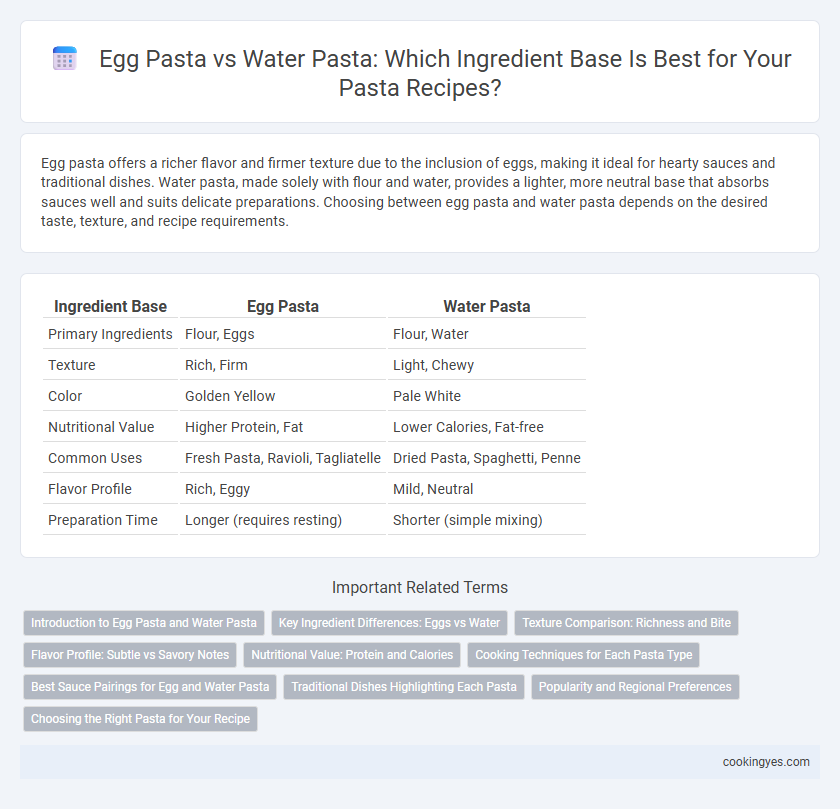Egg pasta offers a richer flavor and firmer texture due to the inclusion of eggs, making it ideal for hearty sauces and traditional dishes. Water pasta, made solely with flour and water, provides a lighter, more neutral base that absorbs sauces well and suits delicate preparations. Choosing between egg pasta and water pasta depends on the desired taste, texture, and recipe requirements.
Table of Comparison
| Ingredient Base | Egg Pasta | Water Pasta |
|---|---|---|
| Primary Ingredients | Flour, Eggs | Flour, Water |
| Texture | Rich, Firm | Light, Chewy |
| Color | Golden Yellow | Pale White |
| Nutritional Value | Higher Protein, Fat | Lower Calories, Fat-free |
| Common Uses | Fresh Pasta, Ravioli, Tagliatelle | Dried Pasta, Spaghetti, Penne |
| Flavor Profile | Rich, Eggy | Mild, Neutral |
| Preparation Time | Longer (requires resting) | Shorter (simple mixing) |
Introduction to Egg Pasta and Water Pasta
Egg pasta incorporates whole eggs or egg yolks into the dough, resulting in a richer flavor and a firm yet tender texture preferred in Italian cuisine. Water pasta uses just flour and water, creating a lighter, more neutral base often found in traditional southern Italian dishes or gluten-free variations. The choice between egg and water pasta affects cooking time, taste, and suitability for different sauces and dishes.
Key Ingredient Differences: Eggs vs Water
Egg pasta incorporates eggs as a key ingredient, resulting in a richer flavor and a denser, more elastic dough compared to water-based pasta. The protein and fat content from eggs contribute to a firmer texture and a golden color, enhancing the pasta's ability to hold sauces. Water pasta relies solely on flour and water, producing a lighter, more delicate texture ideal for thinner pasta shapes and quicker cooking times.
Texture Comparison: Richness and Bite
Egg pasta offers a richer, silkier texture due to its higher protein and fat content from eggs, creating a more tender bite that holds sauces well. Water-based pasta results in a firmer, chewier texture with a slightly less rich mouthfeel, favored for hearty dishes requiring more structure. The choice between egg and water pasta impacts the overall sensory experience, balancing richness with bite intensity.
Flavor Profile: Subtle vs Savory Notes
Egg pasta delivers a richer flavor profile with subtle, creamy, and slightly sweet notes due to the incorporated egg yolks enriching the dough. Water pasta offers a more neutral, savory base that emphasizes the sauce and toppings rather than the pasta itself. This fundamental difference influences recipe pairings and overall dish complexity, with egg pasta often preferred for robust sauces and water pasta suited for lighter, delicate flavors.
Nutritional Value: Protein and Calories
Egg pasta contains higher protein content, averaging around 8 grams per 100 grams, compared to water pasta's 5-6 grams, making it a richer source for muscle repair and growth. In terms of calories, egg pasta typically provides about 150-170 calories per 100 grams, slightly exceeding water pasta's 130-140 calories due to the fat content from eggs. The presence of eggs also adds essential vitamins such as B12 and A, enhancing the overall nutritional profile of egg pasta over water-based varieties.
Cooking Techniques for Each Pasta Type
Egg pasta requires careful handling during kneading and resting to develop elasticity, enabling a tender yet firm texture when cooked al dente. Water pasta benefits from a longer mixing time to hydrate the flour properly and usually requires a shorter boiling duration to prevent overcooking. Both types demand precise temperature control and immediate draining to maintain optimal texture and prevent clumping.
Best Sauce Pairings for Egg and Water Pasta
Egg pasta, rich and tender, pairs exceptionally well with creamy sauces like Alfredo or carbonara, which complement its dense texture and enhance its flavor profile. Water pasta, lighter and more delicate, excels when paired with fresh tomato-based sauces, olive oil, or seafood sauces that highlight its subtle taste. Choosing the right sauce accentuates the unique characteristics of each pasta type, creating an optimal culinary balance.
Traditional Dishes Highlighting Each Pasta
Egg pasta, enriched with eggs and flour, delivers a richer texture and is essential in traditional Italian dishes like tagliatelle al ragu and pappardelle, where its firm yet tender bite complements hearty sauces. Water pasta, made from flour and water, forms the base for classics such as orecchiette and trofie, prized for their lighter, chewier consistency that pairs perfectly with vegetable-based or seafood sauces. Each type reflects regional culinary heritage, with egg pasta dominating northern Italian recipes and water pasta common in southern and coastal traditions.
Popularity and Regional Preferences
Egg pasta dominates Italian cuisine, especially in northern regions like Emilia-Romagna, prized for its rich texture and yellow hue. Water-based pasta, common in southern Italy such as Campania, is favored for its simplicity and lighter mouthfeel, often paired with robust tomato sauces. Popularity trends show egg pasta preferred in gourmet and fresh pasta markets, while water pasta remains staple for dried pasta varieties worldwide.
Choosing the Right Pasta for Your Recipe
Egg pasta, made with a mixture of flour and eggs, offers a richer flavor and firmer texture, ideal for hearty sauces and baked dishes. Water pasta, typically crafted from just flour and water, has a lighter texture and is well-suited for delicate sauces or fresh, minimalist preparations. Selecting the right pasta base depends on the recipe's sauce and cooking method, with egg pasta excelling in robust dishes and water pasta complementing subtle flavors.
Egg pasta vs water pasta for ingredient base Infographic

 cookingyes.com
cookingyes.com